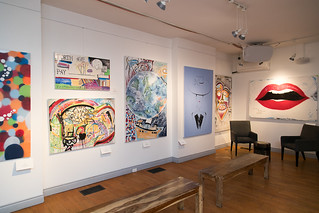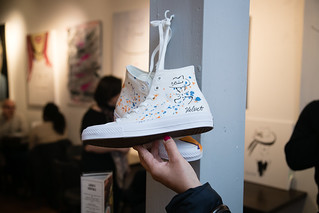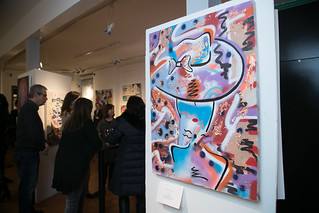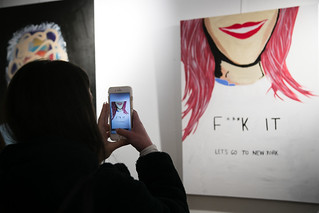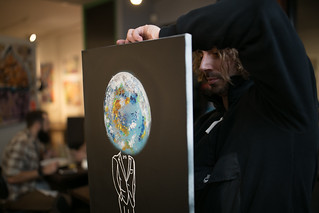Daniel Longo may be colour-blind, but his art is some of the most vibrant you may see as of late. The Toronto-based artist has become known for his captivating work that draws influences from neo-expressionism, Los Angeles street art, and pop culture.

Using well-known fashion icons, cartoons, and everyday objects, Longo’s art inspires a deeper thought and reflection around self-identity and self-awareness. With the ability to see colour absent from the equation, Longo draws from operations of shape, line, texture, and volume in his work.
Extending his canvass beyond the expected, Longo is also the founder and designer of apparel company Colorblind Clothing, a nod to his genetic condition.
Earlier this month (February 13 to 21), Longo inspired both thought and conversation with his latest work, which was displayed at Dundas West’s Art Café and Gallery. We caught up with Longo to hear more about him and his creative process.
What inspired this career path, in particular, a focus on neo-expressionism?
My career was driven and inspired by family, friends, and the beauty in art. The inspiration of neo-expressionism comes from graffiti. Graffiti is a way to express oneself through art without judgment, which is something that has become significantly important to me.
Especially with millennials, it seems the art that is the most eye-catching and photographs the best is what makes its way to social media. Does this ever cross your mind/influence your pieces?
No, my art is a self-expression, not driven by a perception of what one might think is aesthetically pleasing on social media. If I post my artwork for people to enjoy and absorb, it means I am satisfied with that expression. It’s great if they like my work, but its not my driving factor.
What is the most inspiring element about Toronto’s art scene?
It’s a new generation of artists out there now pushing the boundaries. Toronto inspires that creativity with art platforms that range from the AGO programs and Nuit Blanche, to full art installations such as Graffiti Alley.
What’s most challenging thing about Toronto’s art scene?
The most challenging thing about Toronto is the weather. Our state of mind can be influenced by it. These cold winters can get heavy, in contrast for example, to LA artists who come together to paint at the beach all year round. It’s a real centralized community. I find that creating all work indoors sometimes restricts my creativity.
How did clothing become your canvas? Do you think we will see more of a fusion of fashion and art?
As a professional snowboarder, between competitions, I started designing art on T-shirts. It was an easy canvas to travel with. I then created Colorblind Clothing Inc. and expanded into jeans, jean jackets, and shoes, with my original artwork on them. Fashion-art will always be part of the scene and continually evolves.

How does being colour-blind affect/redefine your approach to art?
Being colourblind, means I am not limited by realism of what most people define as true colours. This freedom allows me to create my own colour scale. Being colour-blind simply means I see life in different way.
How do you get into the creative “zone” when making art?
Usually I’m inspired by events and what is relevant in my life and happening around me. Ideas come to me at different times; sometimes when I’m driving, hanging out with friends, or simply alone. I will focus on something for 30 or 40 minutes and then begin.
Why, in your opinion, should we continue to prioritize street art in Toronto?
Street art is like watching live theatre for free, with a large reach. Good quality street art detracts and reduces graffiti-vandalism. You will notice that when a really good piece of street art appears on a wall or building, very little vandalism destroys that work; it’s kind of an unwritten rule I guess. I have been hired by several building owners and managers to take a wall that is covered in graffiti, and recreate a new theme-based wall art that transforms it. Those walls seldom get vandalized. I think we need more of this expressive collaboration.
Photos by Nick Lee



